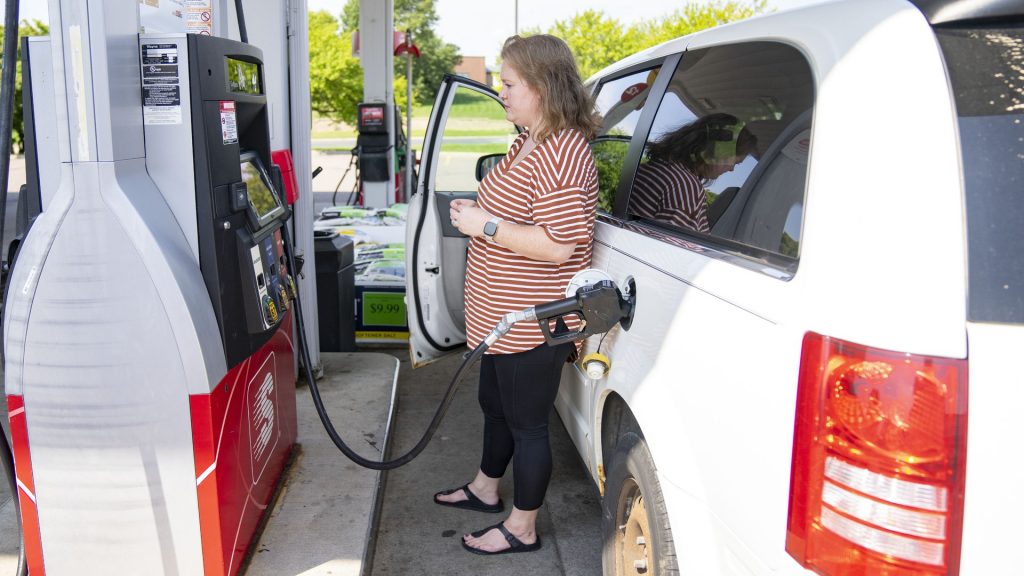$2 gasoline inches into view as average price hits lowest point in 2025

Gasoline prices in many parts of the U.S. are hovering above $2 per gallon, pushing the national average down to $3 or slightly lower. The White House is cheering the declining prices, but energy market experts don’t see eye-to-eye on what’s driving the trend.
The national average cost for conventional gasoline on Monday was $2.90 per gallon — the lowest recorded by the U.S. Energy Information Administration since May 2021. This week, a handful of gas stations in states including Colorado, Louisiana, Oklahoma and Texas are selling gas for less than $2.20 per gallon, according to the website GasBuddy.
Since taking office in January, President Donald Trump has repeatedly highlighted low gas prices, and even falsely claimed that some stations were selling gasoline at $2 per gallon.
Earlier this week, however, a gas station in Colorado briefly offered $2 gas for customers who paid in cash, and multiple stations in Texas are selling gas at $2.08 per gallon, according to research from GasBuddy.
While politicians typically take credit when gas prices are low and cast blame when they’re high, energy economists point to larger market forces at work.
What’s the historical trend in gas prices?
The last time prices for conventional unleaded gasoline were this low was 2021 as demand for gas recovered following the COVID-19 pandemic.
Several metropolitan areas, including Los Angeles, New York, Chicago and Houston, require reformulated gasoline — a blend that produces less air pollution when burned.
When accounting for more expensive reformulated gas, the average price Monday of $3.019 is only the lowest since December 2024. Overall, gas prices have remained relatively stable since September 2024. During the past year, the average price for a gallon of conventional gasoline has stayed within a 30-cent range between $2.90 and $3.20 per gallon.
Patrick De Haan, head of petroleum analysis for GasBuddy, told Straight Arrow News he expects prices to continue declining and for consumers to see lower prices at the pump in 2026 than in 2025.
Why are gas prices dipping now?
Around 42% of the price consumers pay for gasoline is determined by the cost of crude oil, according to the Energy Information Administration. About 20% of the cost comes from refining, while the remaining costs are determined by distribution, marketing and taxes.
Since late September, the price of oil has dropped by around $7 per barrel. This comes as countries in OPEC+, a group of oil-producing countries that sell their oil at a fixed price, have announced hikes in their total production.
Last week, Toril Bosoni, the International Energy Agency’s head of oil industry and markets, warned of an “untenable surplus” in global oil supplies.
Seasonal variation in supply and demand may also play a role, as people drive less in the fall than in the summer.
“It’s the seasonal factors that are now benefitting us,” De Haan said.
Those factors include refineries ramping up production of winter-blend gasoline as inventories of a summer blend remain.
Is this good news or a warning sign of recession?
Not everyone is convinced that seasonal demand fluctuations are playing a key role, and they point to gasoline prices as a warning sign of an economic downturn.
“There is significantly less demand and it’s not seasonal; it’s because of the recession,” said Ed Hirs, an energy economist and lecturer at the University of Houston. “The slowdown in economic activity is obvious.”
The United States is not officially in a recession. The National Bureau of Economic Research defines a recession as “a significant decline in economic activity that is spread across the economy and that lasts more than a few months.
Still, Hirs points to numerous signs of a struggling economy: layoffs in the oil and gas industry, reductions in the U.S. labor force because of immigration crackdowns and more than 700,000 federal employees who are not working due to the government shutdown.
For oil and gas drilling and exploration companies, the low global price of oil coupled with tariffs on steel mean they are less likely to expand oil production.
Doug Sheridan, a veteran of the pipeline industry and managing director of EnergyPoint Research, said that “small changes on the margin” of gasoline demand “can lead to big changes in price.” He added that low gasoline prices might be “a canary in the coal mine for an economic slowdown.”
But other experts are hesitant about the recession explanation.
“Gasoline isn’t going to be the recession indicator that it was historically,” because of the rise of hybrid and remote work following the pandemic, said Skip York, a nonresident fellow at Rice University’s Baker Institute for Public Policy.
York sees the seasonal fluctuations as the key driver of lower gasoline prices, adding that as long as other factors are equal, prices typically decline in September and October compared to summer peaks.
SAN analyzed historical data from the Energy Information Administration and found conventional gasoline prices clearly declined from August to October in four of the past 10 years.
The post $2 gasoline inches into view as average price hits lowest point in 2025 appeared first on Straight Arrow News.





